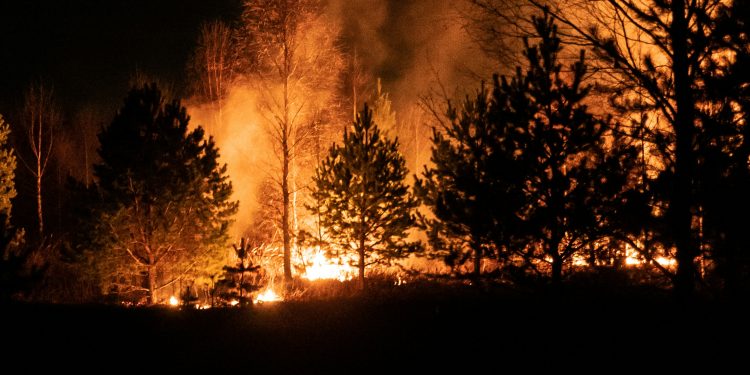Spain faces its most severe wildfire emergency in two decades as 14 major blazes rage across the country, fueled by extreme heat and strong southerly winds. The fires have already claimed seven lives and scorched over 157,000 hectares—nearly double Spain’s annual average and equivalent to Greater London’s entire area. Emergency Services Director Virginia Barcones warned of “extremely worrying” conditions in western regions, where temperatures reached 40°C (104°F) amid a relentless two-week heatwave.
In northwestern Spain, multiple fires in Galicia’s Ourense province merged into a catastrophic mega-blaze, forcing highway closures and paralyzing rail services. The inferno spread to neighboring Zamora province, triggering evacuations as desperate residents like Villanueva de la Sierra’s Loli Baz remained behind to defend homes. Spain’s AEMET weather agency issued extreme fire risk alerts for northern and western regions, with Prime Minister Pedro Sánchez warning of continued danger via social media.
One of Spain’s largest recorded wildfires near Molezuelas de la Carballeda in Castile and León briefly advanced at 4,000 hectares (15.4 square miles) per hour—a rate fire experts call unprecedented. Meanwhile, the Badajoz blaze in Extremadura consumed 2,500 hectares within hours before containment. The disasters disrupted summer travel during a busy holiday weekend, with multiple road closures stranding thousands of travelers.

Authorities arrested three individuals for allegedly sparking fires through reckless actions—a tractor operator in Oimbra (where three firefighters suffered serious burns) and two copper thieves in Galicia’s Costa da Morte. These incidents highlight human factors worsening Spain’s wildfire emergency, which has already injured dozens of first responders. The European Forest Fire Information System confirms Spain accounts for nearly 40% of all wildfire damage in Southern Europe this season.
This crisis extends beyond Spain, with Portugal battling five major fires—including a six-day inferno near Trancoso—that forced 300 evacuations in tourist-favorite Piodão. Lisbon activated the EU Civil Protection Mechanism, requesting four Canadair water-bomber planes to reinforce overwhelmed crews. The simultaneous disasters underscore climate change’s escalating impact, with scientists noting Mediterranean heatwaves now last 20 days longer than in the 1980s.
Meteorologists attribute the unprecedented fire behavior to a dangerous combination of factors: a 14-day heatwave with temperatures 10°C above average, humidity below 20%, and tinder-dry vegetation from months of drought. The EU’s Copernicus Climate Service confirms these fires burn with 30% greater intensity than the 20-year average, releasing record carbon emissions that may further exacerbate global warming.
With peak travel season underway, wildfires have disrupted vacations across Andalucía, Galicia, and Portugal’s central regions. Hotels report mass cancellations as popular destinations evacuate, while stranded travelers crowd alternative transportation hubs. The Spanish Hotel Association estimates €150 million in lost revenue already, with worse expected if fires persist through August.
The government has meanwhile, allocated €200 million for immediate relief, while the EU coordinates additional resources from member states.











